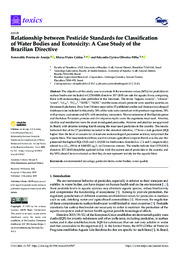Relationship between Pesticide Standards for Classification of Water Bodies and Ecotoxicity: A Case Study of the Brazilian Directive.
Relationship between Pesticide Standards for Classification of Water Bodies and Ecotoxicity: A Case Study of the Brazilian Directive.
Author(s): ARAÚJO, E. P. de; CALDAS, E. D.; OLIVEIRA FILHO, E. C. de
Summary: Abstract: The objective of this study was to evaluate if the maximum values (MVs) for pesticides in surface freshwater included in CONAMA directive 357/2005 are safe for aquatic biota, comparing them with ecotoxicology data published in the literature. The terms ?aquatic toxicity?, ?chronic? ?acute?, ?LC50?, ?EC50?, ?NOEL?, ?NOEC? and the name of each pesticide were used for searches on the research platforms. Data from 534 tests reported in 37 published articles and three ecotoxicological databases were included in this study; 24% of the tests were carried out with producer organisms, 34% with primary consumers and 42% with secondary consumers. Microcrustaceans of the Daphnia genus and the fishes Pimephales promelas and Oncorhynchus mykiss were the organisms most used. Atrazine, alachlor and metolachlor were the most investigated pesticides. Atrazine and alachlor are approved in Brazil, with atrazine ranking fourth among the most used pesticides in the country. The results indicated that of the 27 pesticides included in the standard directive, 17 have a risk quotient (RQ) higher than the level of concern for at least one ecotoxicological parameter and may not protect the aquatic biota. The insecticide malathion, used in various agricultural crops in Brazil, was the one that presented the highest RQs (3125 and 3,125,000 for freshwaters classified as 1/2 and 3, respectively), related to a LC50 (96 h) of 0.000032 g/L in Chironomus ramosus. The results indicate that CONAMA directive 357/2005 should be updated in line with the current use of pesticides in the country, and the MVs should be re-evaluated so that they do not represent toxicity for the aquatic biota.
Publication year: 2022
Types of publication: Journal article
Unit: Embrapa Cerrados
Keywords: Pesticida, Qualidade da Água, Toxicologia ambiental, Water quality
Observation
Some of Embrapa's publications are published as ePub files. To read them, use or download one of the following free software options to your computer or mobile device. Android: Google Play Books; IOS: iBooks; Windows and Linux: Calibre.
Access other publications
Access the Agricultural Research Database (BDPA) to consult Embrapa's full library collection and records.
Visit Embrapa Bookstore to purchase books and other publications sold by Embrapa.

